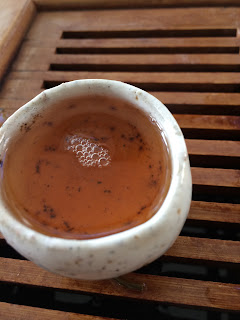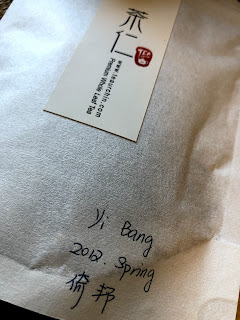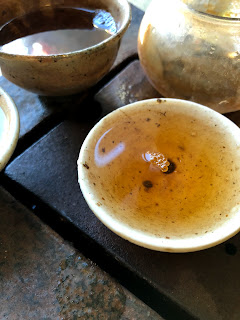First, I can't really say enough good things about Emmett Guzman, the man who has made Yang Qing Hao so accessible to us. He offers us all this for very little. He even picked up the difference in my shipping last order when he quoted me wrong- what a classy guy. I have the highest respect for him. Although I have never ever done this before- I asked him to send some samples , if possible, in my first order with him. In my order was a single sample of this 2007 YangQingHao Huangshan Lingya . No blogger premiums here people, just respect, and I like it... hahahaha.
This puerh is a popular one for the mid-low priced YangQingHao offerings. I appreciate the sample because it is one of the YangQingHao offerings that I was considering a possible blind buy in the future. If you were to purchase this puerh, the full 400g cake would cost you $165.00 ($0.41/gram). According to what I was reading online, this cake seems to be gaining popularity in Western circles.
Let's samples this one...
The dry leaves smell of distant forest, with faint odours of decomposing cedar and distant floral.
Let's samples this one...
The dry leaves smell of distant forest, with faint odours of decomposing cedar and distant floral.
First infusion delivers a crisp wood taste over faint florals and fruits. The wood taste remains the dominant base flavor which the soft, distant florals and plum tastes slowly and evolve. The mouthfeel is sliglthy tingling and soft and nicely coats the mouth.
The second infusion the woody flavor is more pronounced and fills the mouth significantly the softer notes of floral and plum are barely noticeable and barely reside on the breath. The returning sweet coolness in the breath is mild. The aged woody taste is dominant. The qi of this tea is nice and makes the head feel both significantly floaing and foggy but alert.
The third infusion is much the same but the coolness on the breath becomes more as the throatfeel is more obvious now. Wood over aged wood tastes. The mouthfeel is still quite astringent but without drying.
In the fourth infusion the mouthfeel really starts to stick to the teeth. Aged wood over wood is the theme here. There is an initial juiciness where fruit seems like its going to push through but then it submits to aged wood tastes. The qi is a good one- nice interplay of crisp alerting and increase attention along with slight floaty relaxation. I can really notice the heart pumping away in the chest. The fruit and floral are almost gone in the aftertaste now. There is something in there minutes later on the breath but very distant.
The fifth infusion presents with indications of plum and even spice but is quickly whisked away to wood tastes. There is a slight salty-meatiness in there as well now. The mouthfeel is quite pleasant and the throat feel goes to the middle but is mildly stimulating there. The qi is nicely powerful. I feel as though I am quite strung out on this tea- I truly feel high. I feel the need to slow down these rapid infusions and take some breaths.
The sixth infusion is very identical to the fifth. Some slight wildflower note manages to push through in the initial taste and even later on the breath.
The seventh and eighth infusion has a slightly licorice taste in the aftertaste over the wood and barely floral. As my notes indicate, this is not a terribly complex or deep flavored tea. It is clean and simple tasting of mainly common aged wood taste with slight and very brief tweeks of taste along the way. This is not a tasters tea but rather one for the qi. On the downside my body is a touch sensitive to this tea.
The ninth and tenth offers mild mouthfeel with wood aged taste very simple and not much left now. There is a slight coolness with very distant suggestions of fruit and wildflowers. An interesting Chinese yam taste pops up in the tenth infusion and lingers for a few seconds.
This tea is steeped in this manner only yielding simple woody notes from the eleventh onwards.
Overnight steeping brings out nice juicy Asian pear notes very yummy suggesting it could have gone longer.
For my second session. I use up the rest of the dry leaves sample, it is a little less then I would normally use in this pot but not significantly. I confirm the following conclusion about this tea:
For my second session. I use up the rest of the dry leaves sample, it is a little less then I would normally use in this pot but not significantly. I confirm the following conclusion about this tea:
1- In the first infusions, juicier fruit tastes over a bitter dry wood taste with mild cooling sensation in the mouth afterwards.
2- In the middle infusions, smooth woody, astringent, and slightly bitter taste with just a slight cooling in the aftertaste.
3- In the later infusions, the taste is much the same but too watery now a nice juicy throatfeel holds a ball of saliva and in it very woody tastes. Nice.
4- In the very late infusion, this tea is watery, woody, one dimensional, slightly astringent, mildly bitter. Interesting to note is that the Qi sensation in these longer and lower leaf steepings is still noticeable and even stronger than some full sessions of other teas using much more leaf.
5- Didn’t get any unusual allergic reaction from using lesser leaf.
Overall, I can’t see myself ordering this tea. I understand that it is a pretty decent puerh for the price but I would rather spend a bit more for something a bit more interesting from Yang Qing Hao or if I'm looking for power and strength go for the 2007 Huangshan Qizhong. For those that enjoy a nice balance of milder, mainly fruity wood Yiwu and want a full strung out qi sensation someone could easily purchase one of these 2007 Huangshan Lingya and be quite tea stoned and happy with their purchase. This tea has a little strength and depth in its astringency and subtle bitterness but nice Yiwu suggestions in taste. The days I did sample this tea I felt absolutely vibrant for the remainder of the day and I’m pretty sure the tea had something to do with it. It has a really happy qi profile which I like.
When I write it out like that, it makes me wonder why I am not going for a cake of this....
James' (TeaDB) Tasting Notes (early and recent)
Steepster Tasting Notes
James' (TeaDB) Tasting Notes (early and recent)
Steepster Tasting Notes
Peace




















